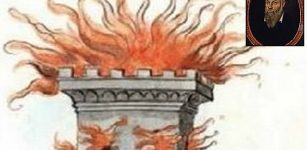Cornucopia – ‘Horn Of Plenty’ – Ancient Symbol And Its Almost Forgotten Meaning
A. Sutherland - AncientPages.com - A cornucopia (from Latin 'cornu copiae') - horn of plenty ) is often depicted in paintings and on friezes. It is a hollow horn-shaped container filled with abundant fruit, coins, flowers, grain, nuts, or any other desirable things.
 A woman holding a cornucopia. Public Domain
A woman holding a cornucopia. Public Domain
It is an ancient symbol of boundless abundance.
Many of us have a cornucopia at home; it can be made of plastic, wicker, metal, wood, or other materials. It can be symbolically filled with something valuable or simply beautiful.
Cornucopia – a horn of plenty – symbolizes wealth, abundance, fertility, and nourishment. It is highly respected by many ancient cultures, including the Celts, whose concept of abundance was central to their religion.
Initially, it represents a mythical symbol originating from the Mediterranean region of Europe. In North America, the cornucopia is associated with the country's great tradition of Thanksgiving, dating back to the Protestant Reformation in 16th-century Europe but the symbol of cornucopia dates back to very ancient times.
Popular Versions Of Cornucopia's Origin
Several mythological explanations suggest the origin of the cornucopia, some of which date back to the 5th century BC. Two of them are believed to be the most popular.
Left: Fortuna, the goddess of good luck, was given the power to bring prosperity to a human being and her attribute is a cornucopia - horn of plenty. Image credit: Vatican, Rome, Italy. Statue of Fortune. Brooklyn Museum; Right: Angel with the horn of plenty. Image credit: Wolfgang Sauber/Wikipedia
According to a version in Greek mythology, the cornucopia belonged to the goat Amalthea ("Nourishing Goddess"), who protected and raised the infant Zeus, who, even as a little boy, had enough strength to break off one of Amalthea's horns while playing. The horn then had the divine power to fill up with everything the owner wanted.
This mythological horn is known as the horn of plenty (cornucopia), and its tradition continues today.
In another myth, the cornucopia was created during one of Heracles' (Roman Hercules) missions to fight with the river god Achelous. During their encounter, Heracles broke off one of his horns.
Gods And Goddesses Were Often Depicted With Cornucopia
The cornucopia became the attribute of several Greek and Roman deities, particularly those associated with prosperity, harvest, or spiritual abundance.
Hades (right-hand side) with a cornucopia and Persephone (left-hand side). Detail from an Attic red-figure amphora, ca. 470 BC. Image credit: Jastrow - CC BY 3.0
Erecura (Aerecura), a goddess often considered Celtic in origin, was often depicted with attributes of fertility as the cornucopia and apple baskets. Also, Epona is associated with cornucopia, Dionysus, and Hades, the god of the underworld and ruler of the dead, who, as Plouton (or Pluto), is a bringer of agricultural, mineral, and spiritual wealth.
In ancient Roman religion, Abundantia was a divine personification of prosperity and abundance. She was often depicted with a cornucopia like the Roman goddess of peace, Pax, who cared for peace (Pax Romana) and wealth and had attributes like an olive branch and a horn of plenty.
Ancient sources confirm that the cornucopia or some versions were found on seals and buildings and imprinted in Jewish coins during the Maccabean times.
A Symbol Of Cornucopia In Ancient Egypt
The cornucopia was also an important symbol for ancient Egyptians.
 Cornucopia in the Statue of Flora in Szczecin, Poland. Image credit: Remigiusz Józefowicz - CC BY-SA 2.5 pl
Cornucopia in the Statue of Flora in Szczecin, Poland. Image credit: Remigiusz Józefowicz - CC BY-SA 2.5 pl
"Horus the Child (the Greek Harpocrates, the god of silence and confidentiality) was one of the best-loved. In the early centuries of the Christian era, he was depicted as a child, sometimes seated in a lotus blossom, a ship, or enthroned as a follower of the sun god. Frequently he carries a cornucopia or a jar…' Lewis Spence writes in his book 'Ancient Egyptian Myths and Legends.'
The legendary Cleopatra VII, the last active ruler of the Ptolemaic Kingdom of Egypt, struck several series of silver coins at the mint in Askalon. On one side of these coins, there is her portrait, and on the reverse (back), Ptolemaic coins have exceptionally only a few motifs; one of them is particularly popular (more than 95 percent) and shows a symbol of a cornucopia (on gold coins).
The cornucopia is still a popular decorative motif, although the symbol's very ancient sacred meaning has long been forgotten.
Written by – A. Sutherland - AncientPages.com Senior Staff Writer
Updated on April 3, 2023
Copyright © AncientPages.com All rights reserved. This material may not be published, broadcast, rewritten or redistributed in whole or part without the express written permission of AncientPages.com
Expand for referencesReferences:
Harrison J. E. Themis: A Study of the Social Origins of Greek Religion
Spence L. Ancient Egyptian Myths and Legends
More From Ancient Pages
-
 Gigantic Engravings Of A Giraffe Created Long Before Egypt As We Know It Existed
Civilizations | Jan 14, 2015
Gigantic Engravings Of A Giraffe Created Long Before Egypt As We Know It Existed
Civilizations | Jan 14, 2015 -
 Biblical Jonah Visits Nineveh – The Evil City
Biblical Mysteries | Nov 9, 2018
Biblical Jonah Visits Nineveh – The Evil City
Biblical Mysteries | Nov 9, 2018 -
 Eleanor Of Aquitaine – Mother Of King Richard The Lionheart And One Of Most Powerful Women Of Middle Ages
Featured Stories | Feb 26, 2018
Eleanor Of Aquitaine – Mother Of King Richard The Lionheart And One Of Most Powerful Women Of Middle Ages
Featured Stories | Feb 26, 2018 -
 Temples At Boncuklu Tarla Are Older Than Göbekli Tepe And Re-Write Ancient History
Archaeology | Dec 10, 2019
Temples At Boncuklu Tarla Are Older Than Göbekli Tepe And Re-Write Ancient History
Archaeology | Dec 10, 2019 -
 Mummified Crocodiles Provide Insights Into Mummy-Making Over Time
Archaeology | Jan 19, 2023
Mummified Crocodiles Provide Insights Into Mummy-Making Over Time
Archaeology | Jan 19, 2023 -
 DNA From 3,800-Year-Old Individuals Sheds New Light On Bronze Age Families
Archaeology | Aug 29, 2023
DNA From 3,800-Year-Old Individuals Sheds New Light On Bronze Age Families
Archaeology | Aug 29, 2023 -
 The Lost Prophecy Reveals Chilling Future Events – The Last Words To Mankind?
Featured Stories | Jan 24, 2015
The Lost Prophecy Reveals Chilling Future Events – The Last Words To Mankind?
Featured Stories | Jan 24, 2015 -
 Aztec Empire: ‘Tlatoani’ – The Ruler With The Ultimate Power In The Land
Ancient History Facts | May 5, 2016
Aztec Empire: ‘Tlatoani’ – The Ruler With The Ultimate Power In The Land
Ancient History Facts | May 5, 2016 -
 Constructing Noah’s Ark – Re-Examination Of The Original Biblical Wording
Biblical Mysteries | Feb 1, 2018
Constructing Noah’s Ark – Re-Examination Of The Original Biblical Wording
Biblical Mysteries | Feb 1, 2018 -
 New AI Technique Will Help To Decode Long Lost Languages Of Ancient World
News | Oct 21, 2020
New AI Technique Will Help To Decode Long Lost Languages Of Ancient World
News | Oct 21, 2020 -
 Mystery Of The Gold From Troy, Poliochni And Ur Solved!
Archaeology | Dec 2, 2022
Mystery Of The Gold From Troy, Poliochni And Ur Solved!
Archaeology | Dec 2, 2022 -
 Discovered Gold Pendant Of Odin And His Horse Sleipnir Might Be Linked To The Heruli Tribe
Archaeology | Apr 16, 2016
Discovered Gold Pendant Of Odin And His Horse Sleipnir Might Be Linked To The Heruli Tribe
Archaeology | Apr 16, 2016 -
 Ancient Human Remains A The Sima De Los Huesos Site Investigated
Archaeology | Mar 15, 2023
Ancient Human Remains A The Sima De Los Huesos Site Investigated
Archaeology | Mar 15, 2023 -
 Our Ancestors Collected Shells 100,000 Years Ago To Create Personal Identity
Archaeology | Oct 6, 2023
Our Ancestors Collected Shells 100,000 Years Ago To Create Personal Identity
Archaeology | Oct 6, 2023 -
 Extremely Rare Jurassic Fossils Discovered Near Lake Powell, Utah
Fossils | Oct 16, 2023
Extremely Rare Jurassic Fossils Discovered Near Lake Powell, Utah
Fossils | Oct 16, 2023 -
 Ancients Built Hindu Temples On A Straight Line Without Access To Satellite Images
Archaeology | Feb 24, 2017
Ancients Built Hindu Temples On A Straight Line Without Access To Satellite Images
Archaeology | Feb 24, 2017 -
 Lamplighters In London: An Important Job In The Victorian Era
Ancient History Facts | May 17, 2019
Lamplighters In London: An Important Job In The Victorian Era
Ancient History Facts | May 17, 2019 -
 Mysterious Inscription On Naxian-Style Sphinx From Dacia Deciphered
Archaeology | Jan 15, 2024
Mysterious Inscription On Naxian-Style Sphinx From Dacia Deciphered
Archaeology | Jan 15, 2024 -
 Fall Equinox Explains Unusual Alignment Of Egypt’s Great Pyramids – Engineer Says
Archaeology | Feb 26, 2018
Fall Equinox Explains Unusual Alignment Of Egypt’s Great Pyramids – Engineer Says
Archaeology | Feb 26, 2018 -
 Adorable Village Of The Little People In Connecticut
Featured Stories | Jul 25, 2019
Adorable Village Of The Little People In Connecticut
Featured Stories | Jul 25, 2019


